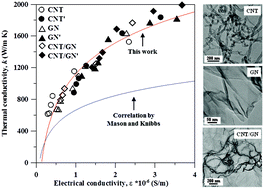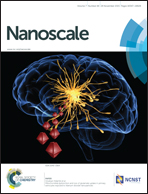Thermal conductivity from hierarchical heat sinks using carbon nanotubes and graphene nanosheets
Abstract
The in-plane (kip) and through-plane (ktp) thermal conductivities of heat sinks using carbon nanotubes (CNTs), graphene nanosheets (GNs), and CNT/GN composites are extracted from two experimental setups within the 323–373 K temperature range. Hierarchical three-dimensional CNT/GN frameworks display higher kip and ktp values, as compared to the CNT- and GN-based heat sinks. The kip and ktp values of the CNT/GN-based heat sink reach as high as 1991 and 76 W m−1 K−1 at 323 K, respectively. This improved thermal conductivity is attributed to the fact that the hierarchical heat sink offers a stereo thermal conductive network that combines point, line, and plane contact, leading to better heat transport. Furthermore, the compression treatment provided an efficient route to increase both kip and ktp values. This result reveals that the hierarchical carbon structures become denser, inducing more thermal conductive area and less thermal resistivity, i.e., a reduced possibility of phonon-boundary scattering. The correlation between thermal and electrical conductivity (ε) can be well described by two empirical equations: kip = 567 ln(ε) + 1120 and ktp = 20.6 ln(ε) + 36.1. The experimental results are obtained within the temperature range of 323–373 K, suitably complementing the thermal management of chips for consumer electronics.


 Please wait while we load your content...
Please wait while we load your content...